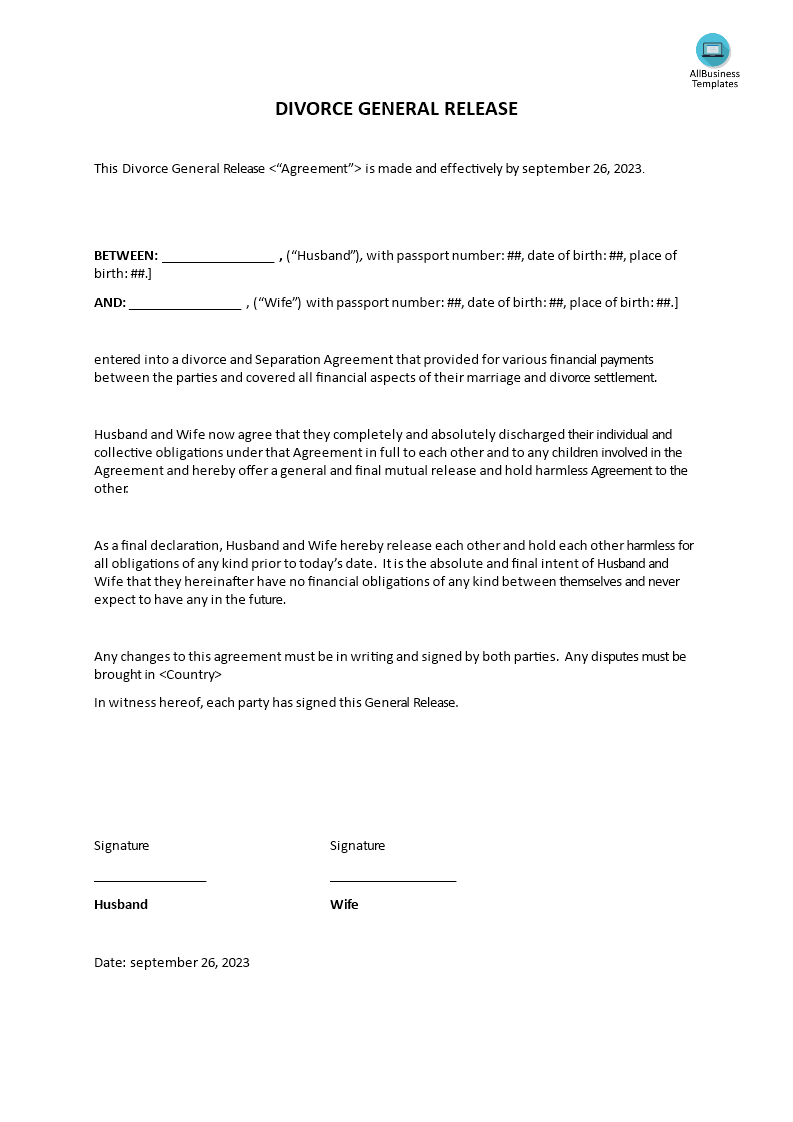Divorce General Settlement Example (Release)
Save, fill-In The Blanks, Print, Done!

Download Divorce General Settlement Example (Release)
Today: USD 3.99
Download It Now

Available premium file formats:
Microsoft Word (.docx)- This Document Has Been Certified by a Professional
- 100% customizable
- This is a digital download (25.03 kB)
- Language: English
- You will receive a link to download the file as soon as your payment goes through.
- We recommend downloading this file onto your computer.
In search of a divorce settlement between husband and wife? How does the divorce settlement work? Our template samples are designed to make it easy to create a comprehensive settlement agreement for divorce. We provide all of the necessary provisions and information to ensure that both parties are on the same page. Download this legal Divorce General Release template now!
A divorce settlement is the legal process by which divorcing spouses reach an agreement on the division of assets, liabilities, child custody, child support, spousal support (alimony), and other important matters related to the dissolution of their marriage. The divorce settlement process can vary depending on the jurisdiction, the complexity of the divorce, and whether the spouses can agree on the terms.
Here's a general overview of how the divorce settlement process typically works:
- Initiating the Divorce: One spouse (the petitioner or plaintiff) initiates the divorce process by filing a divorce petition or complaint with the appropriate court. The other spouse (the respondent or defendant) is then served with divorce papers and has the opportunity to respond.
- Temporary Orders: In some cases, either party may request temporary orders for issues like child custody, support, and property division while the divorce is pending. These orders help establish the status quo until a final settlement is reached.
- Negotiations: The divorcing spouses, often with the assistance of their respective attorneys, engage in negotiations to reach a mutually acceptable settlement agreement. They may participate in mediation or collaborative divorce processes to facilitate discussions.
- Disclosure of Financial Information: Both parties are typically required to provide complete financial disclosures, including income, assets, and debts. This information is crucial for property division and support calculations.
- Property Division: Spouses agree on how to divide marital assets and debts. In equitable distribution states, property is divided fairly but not necessarily equally. Community property states aim for a 50-50 split of marital assets.
- Child Custody and Visitation: If the couple has children, they work out a parenting plan that addresses custody arrangements (legal and physical custody) and visitation schedules (parenting time). The best interests of the children are the primary consideration.
- Child Support: The parties agree on child support arrangements, which may follow state guidelines or be determined based on specific factors such as income, expenses, and the child's needs.
- Spousal Support (Alimony): If spousal support is warranted, the spouses decide on the amount, duration, and terms of payment. This may be based on factors like the length of the marriage and each spouse's financial circumstances.
- Legal Documents: Once an agreement is reached, the attorneys or the parties themselves draft a divorce settlement agreement that outlines all the terms and conditions. This document is often reviewed and revised to ensure clarity and legal compliance.
- Court Approval: The settlement agreement is submitted to the court for approval. If the court finds the agreement fair and legally sound, it is incorporated into the final divorce decree.
- Final Divorce Decree: Once the court approves the agreement, it issues a final divorce decree, officially dissolving the marriage. The decree specifies the terms of the settlement, custody arrangements, child support, and any other relevant details.
- Enforcement: The divorce settlement agreement is legally binding, and both parties are obligated to follow its terms. Failure to comply with the agreement may result in legal actions to enforce it.
It's important to note that divorce laws and procedures can vary significantly by jurisdiction, and some divorces may be more complex than others.
Our trustworthy legal templates are all crafted and screened by professionals. The 3 step process virtually guarantees you can finish and print your legal document in minutes! Feel free to download our basic or advanced template designs, they are intuitive and in several kinds of formats.
Download this professional legal Divorce General Release template if you find yourself in this situation and save yourself time, and effort and probably reduce some of the lawyer fees! Using our legal templates will help you to reach the next level of success in your education, work, and business! However, we still recommend you to consider consulting a local law firm in case of doubt to support you in this matter.
DISCLAIMER
Nothing on this site shall be considered legal advice and no attorney-client relationship is established.
Leave a Reply. If you have any questions or remarks, feel free to post them below.
Related templates
Latest templates
Latest topics
- Excel Templates
Where do I find templates for Excel? How do I create a template in Excel? Check these editable and printable Excel Templates and download them directly! - GDPR Compliance Templates
What do you need to become GDPR compliant? Are you looking for useful GDPR document templates to make you compliant? All these compliance documents will be available to download instantly... - Google Docs Templates
How to create documents in Google Docs? We provide Google Docs compatible template and these are the reasons why it's useful to work with Google Docs... - IT Security Standards Kit
What are IT Security Standards? Check out our collection of this newly updated IT Security Kit Standard templates, including policies, controls, processes, checklists, procedures and other documents. - Letter Format
How to format a letter? Here is a brief overview of common letter formats and templates in USA and UK and get inspirited immediately!
cheese
